THE wrong solenoid valve and lack of equipment to detect operating faults have been blamed for flames emerging onto the deck of the liquified hydrogen tanker Suiso Frontier while docked at Hastings.
The flames did not lead to an explosion or fire, but the event is identified as being a serious incident, in a report released by the Australian Transport Safety Bureau (ATSB) more than one year later.
The 116 metre long Suiso Frontier was on its maiden voyage when it arrived at the Port of Hastings on 20 January 2022 already partly loaded with liquified hydrogen.
The voyage was being made to test the ship’s cargo and monitoring systems, which included loading liquid hydrogen produced from brown coal in the Latrobe Valley.
Environment groups say the use of “dirty brown coal in hydrogen production must be scrapped, due to threats from marine pests, dredging and environmentally, economically unsound carbon sequestration, or CCS” (“Cheers and jeers greet hydrogen ship” The News 1/5/22).
Burning off “boil-off gas” is standard procedure and had been conducted without incident during the voyage from Kobe in Japan to Western Port.
However, when a boil-off was made while the Suiso Frontier was at Hastings, a one metre high yellow flame was spotted coming from a gas combustion unit vent by a sailor conducting a routine safety check of the deck.
The ATSB report stated that as the flame rose up from the vent, it probably reacted with sodium chloride – salt from the environment at sea – ingrained on the inner flue surfaces resulting in the yellow flame.
The report released by ATSB earlier this month, said it made a “limited-scope investigation” into the incident to “allow for greater industry awareness of findings that affect safety and potential learning opportunities”. The ATSB originally said it expected its report to be completed sometime after June 2022.
Its findings confirm that the solenoid was incompatible with the ship’s electricity supply and had burnt out.
The failure of the solenoid caused a damper to close, cutting off the gas combustion unit’s air supply for combustion, cooling and dilution.
The report noted that hydrogen gas “has a wide flammability range of between 4‑75% concentration in air” and was easily ignited, by flames, sparks, static electricity and hot surfaces.
“While pure hydrogen burns with a barely visible flame, it reacts with impurities such as dust or sodium resulting in a yellow flame.” It stated that the Suiso Frontier had “robust fire prevention controls” to eliminate potential ignition sources on its decks.
“The ship was also fitted with gas detectors throughout, and the crew carried portable gas detectors and wore anti-electrostatic boiler suits and boots on deck.”
A subsequent investigation by the gas unit’s German manufacturer had found that “specifications it had issued for the vent damper actuator solenoid valves were incorrect”, resulting in the current required by the solenoid valves being incompatible with the 230volt alternating current (AC) supply from the [unit’s] control system”.
Due to limited space aboard the Suiso Frontier, its gas units were fitted with two fans rather than the four “commonly fitted” on liquified natural gas tankers.
The mismatched power specifications between solenoid valves and the control system had led to the valve being subjected to “damaging vibrations and high temperatures”.
“After a relatively short 400-hour service life, one of the solenoids eventually failed at the time of the incident, most probably due to overheating and material fatigue, leading to a short circuit or functional fault,” the ATSB report stated.
In October 2022 the gas unit’s manufacturer told the ATSB that it had now installed limit switches to the gas combustion unit’s air fan discharge dampers “as agreed with the Suiso Frontier’s manager, Shell International Trading and Shipping Company”.
“The limit switches are designed to monitor the position of the dampers and the system’s control logic has been programmed to automatically stop the [gas unit] if an ‘open’ signal from the dampers is not detected. The modifications were confirmed to be functioning as designed and approved by the ship’s classification society.”
Julia Stockigt, of Save Westernport, said the group had “always been concerned about the hydrogen liquification plant” at Hastings.
“Since Planning Minister Richard Wynne called the project ‘an essential project for Victoria’ in 2019, it has enabled the facility to avoid the scrutiny of an environment effects statement to assess its safety and other impacts,” Stockigt said (“Fire aboard hydrogen ship” The News 4/4/22).
“It’s worth noting that the experimental hydrogen facility hosted by BlueScope is one of a number of major hazard facilities in the vicinity of Long Island Point … and this area in Bayview Road is within close range of the residential areas of Hastings.
“It also concerns us that the safety breach onboard Suiso Frontier appears not to have been reported to the public at the time.”


